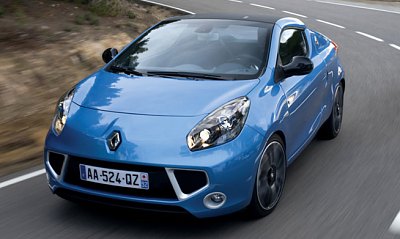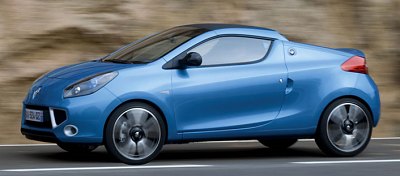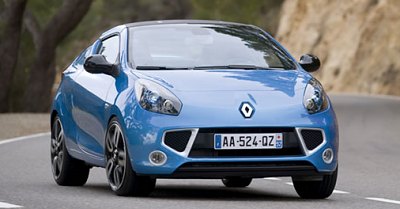|
|
Renault Wind
Debut: 2010
Maker: Renault
Predecessor: No |
|

|
Wind is the first mass application of
Fioravanti roof...
|
When
Peugeot 206CC introduced retractable hardtop technology to mass market
a decade ago, the world immediately got in love with its dual-function
and magical transition between the two forms. Seeing its sales hit
100,000 cars a year,
everybody joined the new gold rush. Within a few years, most European,
Japanese and American manufacturers had been producing coupe-cabriolets
thanks to the help of engineering consultant/contract manufacturer
Webasto, Pininfarina, Heuliez, CTS and Karmann. As coupe-cabriolets
became common sights on road, their wow-factor disappeared and their
disadvantages started taking attention. People realized their packaging
deficiency – weight penalty, loss of luggage space and compromised
styling – are not easy to be justified by their merits. As a result,
some manufacturers revert to conventional soft tops, which are lighter,
faster, more efficient and also cheaper to build. However, apart from
CC and soft top there is actually a third option: Fioravanti roof. It
debuted on Ferrari 575 Superamerica 5 years ago, but the first mass
production application is not seen until today's Renault Wind.

|
Opening or closing the roof takes only
12 seconds...
|
Wind is a
small 2-seater based largely on the mechanicals of Twingo. In concept
and market positioning it is closest to Opel Tigra, though it is even
smaller. While the
Opel employs a retractable hardtop system called TwinTop (a
silly name, by the way), the Renault adopts a rotating roof
system patented by design maestro Leonardo Fioravanti. It is
essentially a Targa, with the B-pillars and rear screen fixed in
place. However, you don't need to detach the roof yourself or find
somewhere to store it, because it will stow away automatically into the
boot. The operation is quick and simple: 1) turn a swivel handle on the
roof to unlatch the roof; 2) press a button on center console; 3) you
will see a lid locating between the flying buttresses open; 4) then the
small roof panel will rotate about the center line of the B-pillars and
drops into the storage space under the lid; 5) the lid closes. The
whole process takes only 12 seconds !
 |
Roof panel actually stored above the
trunk... no wonder the lid between flying buttresses is positioned so
high...
|
The most
brilliant thing of
the Fioravanti roof system is, it adds only 22 kg to the car. No wonder
the Wind undercuts Opel Tigra by 100 kg. To a small car with a small
engine, such weight saving is highly beneficial as it could translate
to a one-second advantage in 0-60 mph acceleration. Another advantage
of the Fioravanti roof is, it does not occupy any luggage space. Its
roof panel is actually stored above the trunk and between the flying
buttresses – like Ferrari 575 Superamerica, but this time covered by a
stylish lid to protect against dirt and water, and to avoid the odd
looks of the Ferrari. This explain why the lid is positioned so high
and the rear view is limited. Free of the roof mechanism and benefited
by the lack of rear seats, the trunk of Wind measures a remarkable 270
liters no matter with roof up or down.

|
It is tuned by Renaultsport, no wonder
it handles better than other supermini-based CC.
|
Young people,
especially female, will love the Wind because of its funky design. With
its 2-seater format and flying buttresses, it could almost deceive
people
as a mid-engined sports car. Unfortunately, the car is simply too tall
to do so. Its very high waist line makes even the optional 17-inch
alloy wheels appear to be too small. It also lacks a wide track to
deliver a sense of stability. After all, this is a supermini in blood
and bones.
Inside, the cabin also looks more Twingo than Alpine. Although the dash
is a dedicated design, it is made of cheap hard plastics that other
supermini already abandoned. The bucket seats look much better,
but you still sit too high and you are aware of the cost savings
through the cheap
steering wheel and switch gears. Space is okay for regular drivers and
a little tight for big guys. Moreover, with a high waist line and small
windows, the Wind does not feel as airy as a roadster should. Your head
is threatened by a chunky windscreen header. Visibility around the
shoulder is predictably poor, blame to the flying buttresses. Forward
vision is not perfect either, as the dash top reflects seriously onto
the windscreen under sunlight.

|
With a high waist line and small
windows, the Wind does not feel as airy as a roadster should.
|
The upshot of
the Targa structure is less buffeting and wind noise, and the chassis
feels stiffer than most other supermini-based coupe-cabriolets. With
the roof opened, you still sense some chassis shake and steering
vibration over undulations. Roof up, these flaws disappear and it
becomes impressively refined. The Wind is tuned by Renaultsport, no
wonder it handles better than other supermini-based CC. Owing to
stiffer springs and dampers, its low speed ride is firm, but once you
up the pace it displays good damping and pretty taut body control. Its
205/40 tires offer plenty of grip. Its electric power steering is still
the Achilles' heel, being springy and feel-less, but ignoring its
coldness you will find the steering actually reacts sharply to your
input. Its nose turns into the corner sharply. Its back end responds to
your throttle control. All these make it surprisingly fun to drive.
 |
133hp engine begs you to rev it... and
it's quite fun...
|
Two engines
from the Twingo are offered - 100hp 1.2 TCE turbo and 133hp 1.6 VVT.
The former is a torquey, low-stressed engine for the majority, but
those asking for driving fun matching the good chassis is the
Renaultsport-tuned naturally-aspirated 1.6 engine. Its peaky manner and
loud exhaust are flawed for everyday driving, but it always beg you to
access its 7000 rpm redline, which is fun if your mood is right. Its
old-school raw driving fun is rare today. That said, straight line
acceleration is not as impressive as subjectively how it feels. It
takes 8.7 seconds to go from 0-60, half a second longer than the
Renaultsport Twingo RS fitted with the same engine, blame to the extra
120 kg it carries.
The Wind is not meant to be a sports car or a 2-seat hot hatch. It is
purely a style-led roadster designed for the entry-level market. Its
combination of very affordable price, pretty good driving fun and a
clever, less compromising retractable roof guarantee a sales hit,
perhaps not as hot as the old Peugeot 206CC, but should be more
successful than most other supermini-based CC currently on sale.
|
| The
above report was last updated on 13 Jul 2010. All Rights Reserved. |
| Specifications
|
| General remarks |
| Layout |
| Chassis |
| Body |
| Length / width / height |
| Wheelbase |
| Engine |
| Capacity |
| Valve gears |
| Induction |
| Other engine features |
| Max power |
| Max torque |
| Transmission |
Suspension layout
|
| Suspension features |
| Tires |
| Kerb weight |
| Top speed |
| 0-60 mph (sec) |
| 0-100 mph (sec) |
|
| Wind 1.2TCE |
Front-engined, FWD
|
| Steel monocoque |
| Mainly steel |
| 3833 / 1689 / 1381 mm |
| 2368 mm |
| Inline-4 |
| 1149 cc |
SOHC 16 valves
|
| Turbo |
| - |
100 hp
|
112 lbft
|
5-speed manual
|
F: strut
R: torsion-beam
|
| - |
| 195/45R16 |
1131 kg
|
| 118 mph (c) |
9.9 (c)
|
| - |
|
| Wind 1.6 |
Front-engined, FWD
|
| Steel monocoque |
| Mainly steel |
| 3833 / 1689 / 1381 mm |
| 2368 mm |
Inline-4
|
| 1598 cc |
DOHC 16 valves, VVT
|
| - |
| - |
133 hp / 6750 rpm
|
118 lbft / 4400 rpm
|
5-speed manual
|
F: strut
R: torsion-beam
|
| - |
| 205/40R17 |
1173 kg
|
125 mph (c) / 119 mph*
|
8.7 (c) / 8.8*
|
| - |
|
|
|
Performance
tested by: *Quattroruote
|
Copyright©
1997-2010
by Mark Wan @ AutoZine
|
|
|





